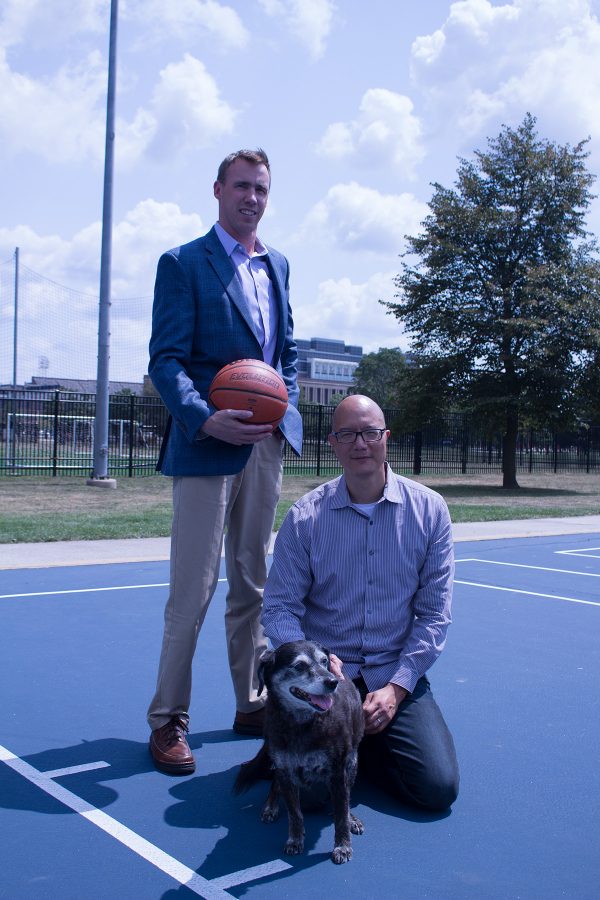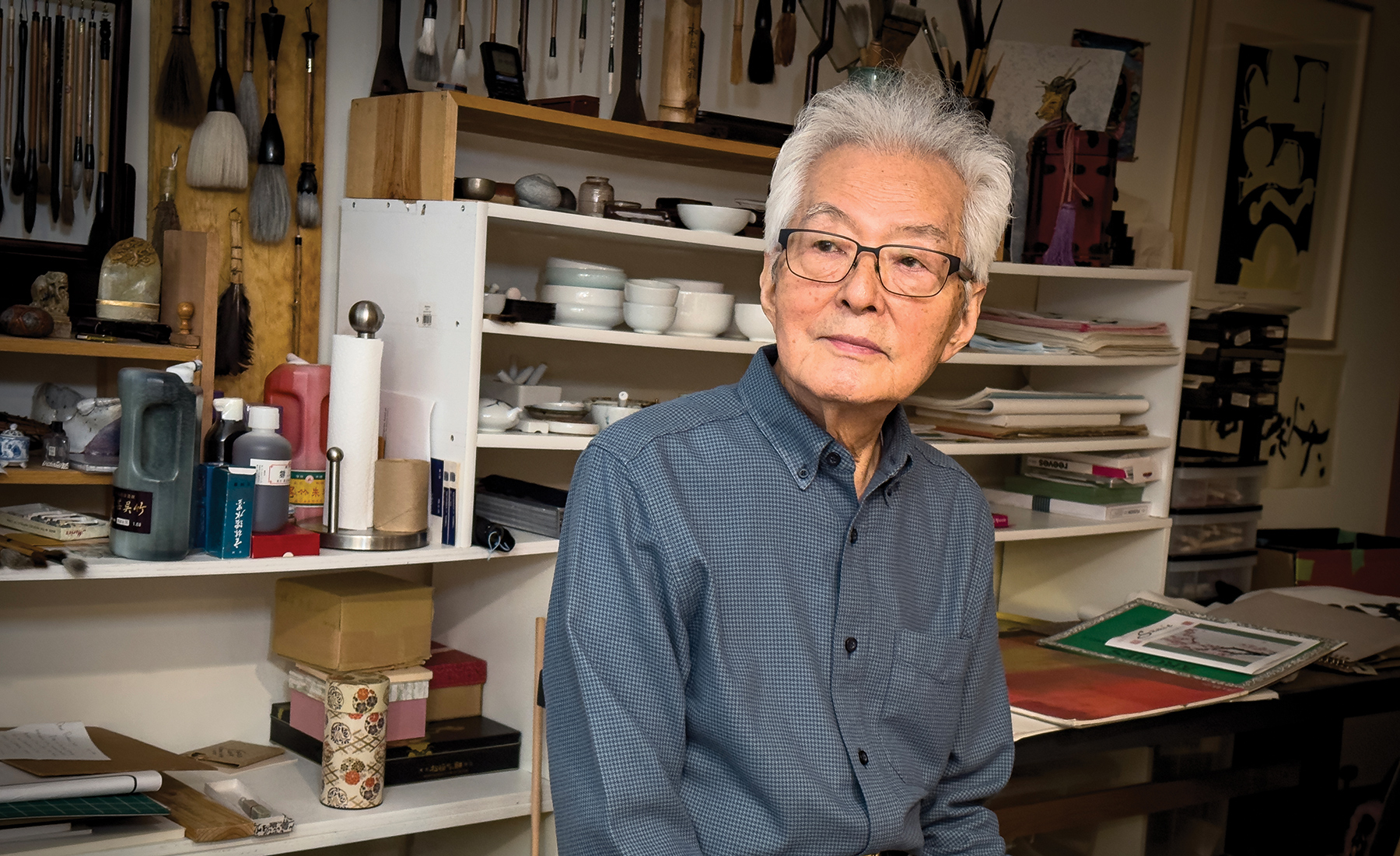
THINK BIG.
That’s how chemist Paul Hergenrother approaches science. He and veterinary oncologist Timothy Fan are taking on one of the biggest challenges they can: developing new drugs to fight brain cancer. Before they collaborated in the lab, they met at pick-up games on the court. Years later, with federal funding as well as an $11 million investment from an anonymous donor, they have seen promise in the treatment of pet dogs with brain cancer.
Now the drug is in human clinical trials and could radically change the treatment for one of our most deadly cancers.
✦ ✦ ✦
The beauty of a college town is that it is large enough to have hundreds of subject experts in diverse areas of study, but small enough to run into Nobel Prize winners on the bus or find collaborators in unique places. Paul and Tim first ran into each other at pick-up basketball games at the ARC, but it wasn’t until Paul gave a talk on campus about his discoveries that Tim realized the potential for collaboration. Unable to attend the talk, Tim read Paul’s paper and contacted him right away.
“I was fascinated by the research that Paul’s lab had been doing over the past several years to culminate in that really impactful paper,” said Tim. “We met for lunch, and began to think about where the synergy might lie between his lab and my work at the College of Veterinary Medicine. I wanted to figure out how we could begin to integrate into the novel drug development path.”
“When I met with Tim at that first lunch, I recognized him from the court. We were both ballers,” Paul laughs, “so I knew I could trust him.”
Paul and Tim immediately saw an opportunity to help Tim’s veterinary patients while also collecting data that would be vital to further develop PAC-1 for use in humans as well. Tim was treating dogs with certain cancers that had little to no options for treatment. Several of the cancers that dogs get are very similar to how the disease presents in humans. As companion animals, they are exposed to many of the same environmental factors we are; dogs also have genetic predispositions to developing the disease, much like we do.
Most cancer drugs are tested on mice, and Paul explains that may be one possible reason many cancer drugs fail. The mice are artificially given cancer for the purpose of the drug trial, and they do not share our environment in the same way dogs do—two important factors. “We think that if we put things forward on this much higher bar, which is efficacy in these veterinary patients who have metastatic cancer and heterogeneous tumor populations just like humans do, it would have a better chance of success,” said Paul.
✦ ✦ ✦
Cancers in the brain are notoriously hard to treat, in part because most drugs don’t pass from the blood into the brain, making it impossible for the medicine to reach a tumor. However, during their investigation into compounds that might provide targeted cancer treatment, scientists in Paul’s lab uncovered PAC-1’s somewhat surprising ability to cross the blood-brain barrier. This rare ability is what gives PAC-1 such promise.
According to Paul, nearly 95% of cancer drugs tested in humans fail. But PAC-1’s way of killing cancer cells is different than what is currently found in the market—use of the drug actives procaspase-3, a protein in the cancer cell that encourages it to self-destruct. Their studies have found that when PAC-1 is used in conjunction with other conventional cancer treatments, the size of brain tumors in dogs shrink.
“This is a uniformly fatal disease, and an area of unmet need. The data in dogs, although limited so far, has been quite promising,” said Paul.
Tim explained that often “curing cancer is often very difficult in pet dogs or cats because they usually present with much more advanced disease.” While PAC-1 is not yet proving to be a cure, Tim has measured its success on the reduction in volume of tumors and the dog’s ability to regain a more normal quality of living. “I can say that the pets that we have enrolled in our clinical trials have all uniformly have improved quality of life.”

✦ ✦ ✦
Of course, improving drug compounds and analyzing statistics is only the “how” of treating cancer. Paul and Tim are also concerned with the “why.”
“The ability to help these canine cancer patients and their owners is something that has driven us forward from the beginning. There is a real need out there for treating canine cancer, and obviously we also want to advance the drug to treat the human disease,” said Paul.
Pretzel is a dachshund who suffered her first seizure in March 2016. Tests a few weeks later revealed she had a brain tumor and likely had only six months to live. However, her veterinarian told owner Donna Gescheidler that Pretzel qualified for the PAC-1 trial. Donna had a tough decision to make.
“It was quite overwhelming and bittersweet. My baby girl has cancer—do I treat with conventional radiation and temozolomide or do I add the new drug and hope all goes well? I read all I could find on PAC-1 and learned about Dr. Fan’s work. I wanted Pretzel to live as long a good quality of life as possible and the PAC-1 seemed to bring me that hope.”
Pretzel received her first dose of PAC-1 on April 4, 2016. “To this day, Pretzel has never had another seizure,” said Donna. “She has never gotten sick on the treatments, never lost any hair. Actually, to see her, one would never know that she has cancer. She loves her walks, loves her belly rubs, and car rides. I am thankful for every day with her. I love her dearly, and am very grateful that she was able to participate in the study, not only for her health, but for all others she may help in the future.”
Luzviminda Cruz’s boxer/bulldog Breta has also seen an improvement in her health as well, including fewer seizures. “It gave us renewed hope for the future to give us more time with Breta,” said Luzviminda.
Both Breta and Pretzel live hours away from campus, but every shipment of medicine included a reassuring note from Tim, and he follows up with his patients to see how they are doing.
“Pet dogs are forever loving and accepting of who we are has human beings, so finding ways to help them live longer and healthier lives seems the natural and right thing to do, and is one way that we can give back to them during times of need,” he said.
This story was published .









